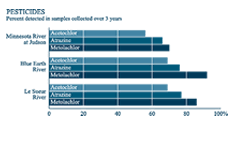Pesticides in the Minnesota River Basin
What are Pesticides?A pesticide is any substance or mixture of substances intended for: preventing, destroying, repelling, or mitigating any pest. Though often misunderstood to refer only to insecticides, the term pesticide also applies to herbicides, fungicides, and various other substances used to control pests. Under United States law, a pesticide is also any substance or mixture of substances intended for use as a plant regulator, defoliant, or desiccant. |
|||||
Who Monitors Pesticides?The Minnesota Department of Agriculture (MDA) is the lead state agency for all aspects of pesticide and fertilizer environmental and regulatory functions. To better understand pesticide use in Minnesota, the MDA conducted surveys designed to get a better understanding of existing farm practices regarding agricultural inputs such as fertilizers, manures and pesticides. The surveys found corn and soybean acreage accounted for the majority of pesticide applications. Pesticides were applied to over 95% of the major crops found in the study sites. (For more information, see the MDA website. The MDA Monitoring and Assessment Unit collected pesticide samples from the Le Sueur River at Highway 66, the Blue Earth River below the Rapidan Dam, and the Minnesota River at Judson. Samples have been collected during 2000, 2001, and 2002. Over the three-year period, the herbicides metolachlor, atrazine and acetochlor were the most frequently detected compounds in these rivers. These herbicides are typically applied to corn and soybean fields for general weed control. |
|||||
 |
What is the status of pesticides in the Minnesota River Basin?� Water quality sampling from 2000-2002 reveal that metolachlor was the most commonly detected pesticide with detections in approximately 82 percent of the surface water samples collected. During this same three year period atrazine and acetochlor were detected in 73 and 64 percent of the samples, respectively. Runoff-adjusted yields indicate that the Le Sueur River and the Minnesota River at Judson delivered approximately the same pesticide yield per inch of runoff (0.28 lbs). Both the Le Sueur and the Blue Earth Rivers yielded much less total pesticide per inch of runoff in 2002 than in the previous two years. As in the previous two years, the Le Sueur River Watershed displayed the highest cumulative pesticide yield at over 1.5 pounds per square mile. The percent land use in agricultural row crop for the Judson, Le Sueur and Blue Earth Watersheds were estimated at 60, 82 and 85 percent respectively. In 2002, concentrations for most compounds peaked during late May and early to mid June storm events. Metolachlor concentrations typically peak earlier in the year (March or April) because the product is commonly applied in the fall. Peak concentration periods for most compounds generally occur with the first significant post-application runoff events. |
||||
|
References: |
|||||
|
This page was last updated 9/15/04 |
|||||
